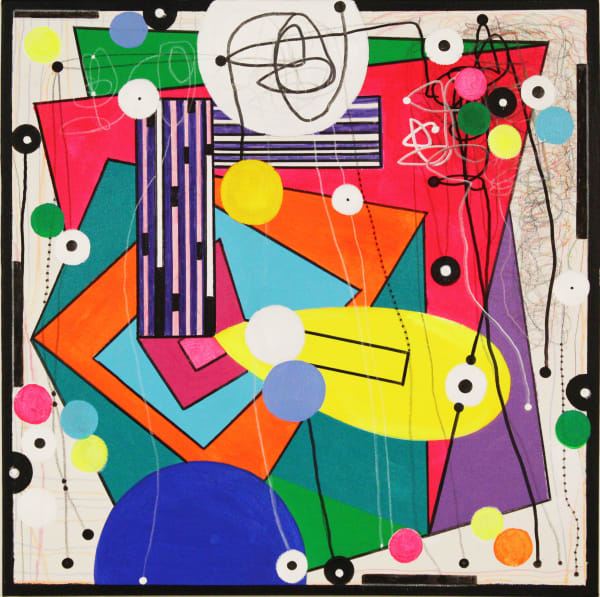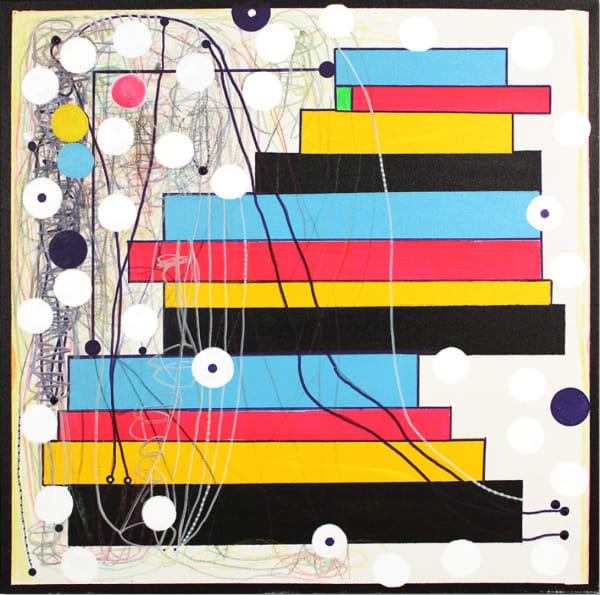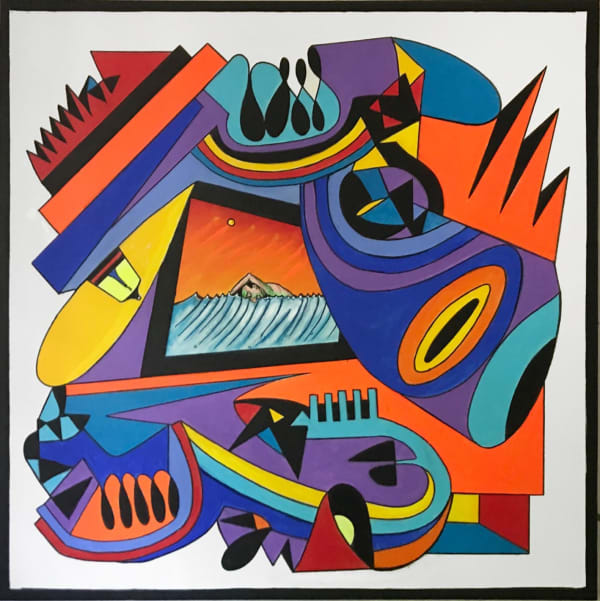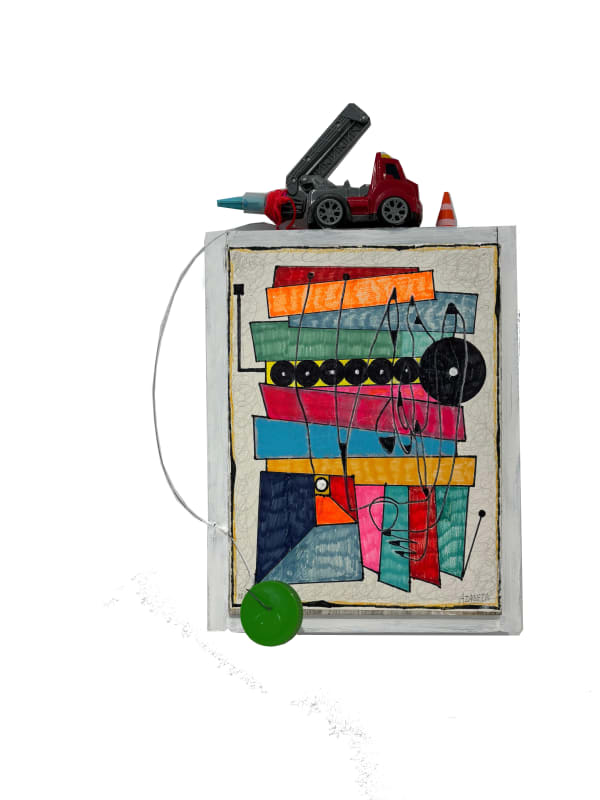-
LUIS CRUZ AZACETA: POETIC INCONGRUITIES
Solo Show - Curated by JANET BATET AND CLAUDIA TABOADA
Text by Janet Batet
SEPTEMBER 7 - DECEMBER 14, 2024
Design District
21 NE 39th Street, Miami, FL 33137
-
Poetic Incongruities will feature key works from his extensive career, including pieces from his well-known series on the Cuban diaspora, as well as newer works that break in visuality but continue to explore themes of conflict and survival. Azaceta's distinctive use of color often evokes the SMPTE color bars of old televisions, creating a striking visual incongruity. These bright, joyful hues create a striking contrast with the often controversial and somber subjects he addresses. This juxtaposition not only captures the viewer's attention but also deepens the impact of his commentary on societal issues, making the clash between form and content a powerful tool in his artistic expression.
-

Luis Cruz Azaceta
Celebration, 2019Mixed media on canvas
40 x 72 in
101.6 x 182.9 cm -
Luis Cruz Azaceta, a celebrated Cuban-American artist, is renowned for his powerful and emotive art that explores themes of exile, displacement, and identity. "Poetic Incongruities" brings together a selection of his paintings, drawings, and mixed-media works that highlight the contradictions and complexities of the human condition. Azaceta’s work is characterized by its vibrant colors, dynamic compositions, and poignant subject matter. His art often addresses social and political issues, reflecting his own experiences as an exile and the broader human struggle for freedom and dignity. Through his unique visual language, Azaceta creates a space where beauty and brutality coexist, inviting viewers to engage with the incongruities of life.
-

-
Swimming, swimming swimming. This fixed obsession is the only lifeline. Swimming, swimming swimming. The central character, Azaceta himself, isolated, water up to his neck and encapsulated in a closed, oppressive space, swims in an a frenzy, agonizing ritournelle. Swimming always at the same point—tireless effort. Azaceta is like Sisyphus trapped by his own destiny.
Swimming in dreams represents the connection to our deeper inner feelings. Much like a dreamscape, the blank canvas is a mirror to Azaceta’s inner world, where the conscious mind’s boundaries are softened, allowing the subconscious to manifest in plain sight.
Swimming, in Azaceta’s work, emerges as a powerful metaphor for the ceaseless quest for identity, a visual allegory for survival, and a symbolic act of navigating the existential void created by exile and displacement. His repeated depictions of figures swimming through vast, overwhelming waters are the reflection of the artist’s own biography. For Azaceta, swimming is not merely a physical act but a deeply psychological one—a metaphor for the perpetual search for self, meaning, and belonging in the face of dislocation.
The water in Azaceta’s imagery often appears as an infinite yet confined, engulfing force—an ambiguous space where the swimmer is suspended, caught between two shores, much like the exile caught between two worlds. In this watery, altered states, identity is fluid, continuously shifting, just as the swimmer moves but never quite arrives. The obsessive repetition of swimming suggests a tireless, almost Sisyphean effort to grasp something stable in a world that refuses to offer certainty. Here, the act of swimming becomes a search for selfhood in an unanchored existence, where the individual must navigate the turbulent waters of displacement, memory, and alienation.
Azaceta’s swimmers are isolated, solitary figures adrift in a hostile environment, embodying the existential struggle in the search for oneself. The water, at once a lifeline and a threat, underscores the precarious nature of this journey—a constant oscillation between survival and drowning, between the possibility of finding one’s way and the risk of being lost forever. Through this recurring motif, Azaceta poignantly captures the fragility of identity and the endless striving for connection and belonging in a fragmented, globalized world. The swimmer’s quest is a metaphor for the artist's own search for meaning in the dislocated spaces of his life—a quest that echoes the universal human condition of seeking identity amidst chaos.
This is the beginning—and the end— of our endless journey.
-

Luis Cruz Azaceta
Hope in the age of Covid 1-2-3 (Triptych), 2021Acrylic and ink markers on paper
39 1/2 x 77 1/4 in
100.3 x 196.2 cm -
Luis Cruz Azaceta’s work emerges as a visceral chronicle of displacement, and the rupture of identity—a visual testament of the trauma inflicted by political violence, and social dislocation. Through his distinct approach to abstraction and expressionism, Azaceta maps the psychic and physical scars of exile, where the human figure becomes a battleground of both personal and collective suffering.
These symbolic maps are highly emotional landscapes that reflect the instability and uncertainty of our existence. His cartography captures the internal landscapes of the mind—where memories of home are distorted by time and distance and where the search for belonging becomes a psychological journey. In this sense, Azaceta’s maps are mental maps, charting not just physical territories but the inner experience of displacement. These maps always lack clear paths or coherent borders. Twisted on themselves they become labyrinths, traps, riddles without answers, but the only possible refuge, suggesting that for those unrooted, identity and place are constantly shifting, elusive concepts. His use of cartographic elements becomes a metaphor for the constant renegotiation of self that exiles and migrants must undergo, when navigating complex cultural, political, and emotional terrains, often without clear direction or a definitive destination.
Luis Cruz Azaceta’s maps are inextricably linked to his own biography, serving as visual manifestations of the dislocation and fragmentation he experienced as a Cuban exile. Born in Havana in 1942, Azaceta fled to the United States in 1960 during a period of intense political upheaval. His forced displacement from his homeland became a central theme in his work, and his maps reflect the psychological impact of this rupture. His art grapples with the trauma of being caught between worlds, where identity is fragmented and constantly renegotiated, much like the shifting landscapes of his maps.The map then becomes a narrative of survival—of navigating the psychological terrain of loss, memory, and displacement.
Azaceta’s intricate mental cartographies are the manifestations of the psychological territories of a fragmented existence. His approach dismantles the notion of borders as fixed lines, instead presenting them as porous, mutable, and reflective of the inner turmoil experienced by individuals in a state of liminality. Through Azaceta’s lens, the map transforms into a symbol of dislocation—not only of physical displacement but of the deeper, more insidious separation from identity and belonging in an increasingly fractured world. Marked by distortions and abstraction, his cartographic compositions resist the traditional logic of navigation. They echo the fragmented and chaotic nature of contemporary life, where the self becomes unmoored, constantly renegotiating its place in a landscape that is as elusive as it is oppressive. These maps are both a testament to survival and a manifestation of the dissonance that comes with living on the edge of societal norms, where isolation and alienation persist despite global connectivity. Through this visual language, Azaceta offers us a profound meditation on the impossibility of grounding oneself in an ever-shifting terrain, rendering the internal chaos with palpable immediacy.
-
-
 Luis Cruz AzacetaHero - Innocent Incongruities 6, 2023Mixed media, drawing construction17 3/4 x 8 1/4 x 3 in
Luis Cruz AzacetaHero - Innocent Incongruities 6, 2023Mixed media, drawing construction17 3/4 x 8 1/4 x 3 in
45.1 x 21 x 7.6 cm -
 Luis Cruz AzacetaInnocent Incongruities 4, 2019Mixed media, drawing construction20 x 14 x 7 in
Luis Cruz AzacetaInnocent Incongruities 4, 2019Mixed media, drawing construction20 x 14 x 7 in
50.8 x 35.6 x 17.8 cm -
 Luis Cruz AzacetaInnocent Incongruities 5, 2023Mixed media, drawing construction16 3/4 x 11 1/2 x 4 1/2 in
Luis Cruz AzacetaInnocent Incongruities 5, 2023Mixed media, drawing construction16 3/4 x 11 1/2 x 4 1/2 in
42.5 x 29.2 x 11.4 cm
-
-

Luis Cruz Azaceta
Profile, 2021Acrylic on canvas
48 x 72 in
121.9 x 182.9 cm -

-
From the start, the work of Luis Cruz Azaceta has centered on an inquiry into the contemporary human condition. We are presented with an off-centered individual, both a victim and a reflection of circumstances that overcome him and limit his personal fulfillment. Confronted with migratory dispersion, urban violence, pandemonium, or natural catastrophes, the subject in Azaceta’s work is overpowered by the omnipresent feeling of oppression, fear, and uncertainty that threatens our existence. If this feeling first manifested in his early work through recurring images of dismembered bodies, decapitations, and acts of cannibalism—formally identified with gestural expressionism—by this point in Azaceta’s work, the individual subsists by their traces only palpable through the catastrophe that annihilated them.
Charged with the faceted spirit of cubist decomposition, the works emerge as metaphors for the loss of confidence in progress that typifies our era. Planes of color, vibrant as gems, are driven by waves of black clouds, oil stains, teeth that grow gigantically, threatening objects invading the sky, which emerge as the new contemporary landscape.
The broken landscape, characterized by areas of color and monochrome responds to the breakdown of the natural and social orders of our society. As a contrast to an utopic notion that guides us toward modernity, Azaceta’s work places itself in dystopia. As an expression of that repellent daily reality, these landscapes hang like swords of Damocles that, far from portraying fictionalized states, reveal the imminently disintegrating character of our contemporary environment.
If we were to find a rhetorical figure to define the work of Luis Cruz Azaceta, it would be that of the epic minstrel. That medieval figure who traveled from town to town, keeping alive in the collective memory the heroic deeds of solitary heroes. However, there are fundamental shifts in the narrative.
On one hand, the original epic has been replaced by events of tragic magnitude that overwhelm the central character. We no longer speak of lone heroes capable of saving a kingdom from invaders. Instead, we speak of masses of displaced people, of wars, of death, of disease. The solitary hero has been replaced by an invisible, collective hero—a victim of forces far greater than themselves. In Azaceta’s work, the protagonist becomes what Zygmunt Bauman calls "the human waste" of the global era. These disposable humans do not belong to the world they paradoxically sustain. The great cities expel them. As Bauman suggests, this new invisible and collective entity belongs to asylums, refugee programs, and prison systems. This is the protagonist in Azaceta's work—a figure with whom the artist viscerally identifies. Azaceta has often described himself as an "outcast," a pariah, fully embracing the role of the marginalized in a world that treats them as disposable.
Luis Cruz Azaceta’s work is a harrowing yet luminous exploration of the human condition—where the epic grandeur of heroic myths is recast as a story of collective suffering, displacement, and survival. Through his intricate visual language, Azaceta maps the fragmented landscapes of modern life, echoing the dissonance of a globalized world that often renders the individual invisible, discarded, and alienated. His obsessive depiction of swimming becomes a poignant metaphor for this endless search for identity and meaning, a Sisyphean struggle to stay afloat in the overwhelming tide of exile, trauma, and isolation.
In their chaotic abstraction, Azaceta’s maps reject the notion of fixed borders and directions, offering instead mental cartographies of the inner turmoil that comes with living in a state of liminality—where belonging and identity are constantly renegotiated in a fractured and unforgiving world. His canvases, charged with emotional and political intensity, not only reflect his own experience as a Cuban exile but also speak to the broader disillusionment and fragmentation felt by many in today’s society.
Through his art, Azaceta transforms the experience of displacement into a collective narrative, making visible those who are too often unseen—the human "waste" of the global era. And yet, within this darkness, his work offers moments of color, of resilience, of rainbows flickering through the chaos, suggesting that even in the most fractured landscapes, there remains the potential for survival, for light, for some semblance of hope. In the end, Azaceta’s art is both a reflection and a resistance, a testament to the endurance of the human spirit in the face of overwhelming forces. As we swim through the waters of contemporary life, his work reminds us that the journey is ongoing, fraught with danger but not without moments of profound beauty.
Swimming. Swimming. Swimming. Drowning. Rainbows in the darkness.
Janet Batet
Summer, 2024.
Copyright © 2025 Pan American Art Projects
Facebook, opens in a new tab.
Twitter, opens in a new tab.
Youtube, opens in a new tab.
Instagram, opens in a new tab.
LinkedIn, opens in a new tab.
Artsy, opens in a new tab.
Send an email
Ver en Google Maps
This website uses cookies
This site uses cookies to help make it more useful to you. Please contact us to find out more about our Cookie Policy.













